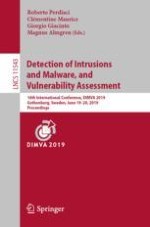2019 | OriginalPaper | Chapter
On Deception-Based Protection Against Cryptographic Ransomware
Authors : Ziya Alper Genç, Gabriele Lenzini, Daniele Sgandurra
Published in: Detection of Intrusions and Malware, and Vulnerability Assessment
Publisher: Springer International Publishing
Activate our intelligent search to find suitable subject content or patents.
Select sections of text to find matching patents with Artificial Intelligence. powered by
Select sections of text to find additional relevant content using AI-assisted search. powered by
